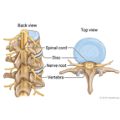Cervical Spondylosis
Topic Overview
What is spondylosis?
Spondylosis is age-related change of the bones (vertebrae) and discs of the spine. These changes are often called degenerative disc disease and osteoarthritis.
These changes don’t always cause symptoms. But they are a common cause of spine problems that can range from mild to severe.
What causes cervical spondylosis?
As your body ages, the discs between the bones of the spine become stiffer and can break down. The bones also wear down and can grow bone spurs.
When this condition is in the neck, it’s called cervical spondylosis.
What are the symptoms?
There are often no symptoms. When there are symptoms, neck pain and stiffness are the main ones. They are usually worse in the morning and get better throughout the day. You may also have a headache.
If bony growths are pushing against a nerve root or the spinal cord, you may have numbness, tingling, weakness, or an aching, shooting pain in your arm or leg.
How is cervical spondylosis diagnosed?
Cervical spondylosis can usually be diagnosed based on your history of symptoms, a physical exam, and imaging tests. These are tests that produce various kinds of pictures of your body. Such tests include:
- X-rays. They can help measure the extent of arthritis or injuries to the bones.
- MRI. This test checks your spinal nerves and looks for disc problems.
- CT scan. This test checks your spinal canal, bones, and joints.
How is it treated?
Pain and stiffness are first treated with ice or heat and with over-the-counter medicines. Physical therapy and daily exercises can be helpful.
If these treatments aren’t helping you enough, you may need other treatments. This might be more likely to happen if you have spine problems such as a herniated disc or spinal stenosis. In some cases, a shot of medicine in the joint area may offer short-term relief. For a severe problem, surgery may be an option.
Current as of: June 26, 2019
Author: Healthwise Staff
Medical Review:William H. Blahd, Jr., MD, FACEP – Emergency Medicine & E. Gregory Thompson, MD – Internal Medicine & Adam Husney, MD – Family Medicine & Kathleen Romito, MD – Family Medicine
This information does not replace the advice of a doctor. Healthwise, Incorporated, disclaims any warranty or liability for your use of this information. Your use of this information means that you agree to the Terms of Use. Learn how we develop our content.



